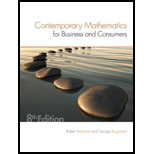
Concept explainers
(a)
To calculate: The total worth of the investment when the certificate matured from the following investment;
1: Deposition of $10,000 at 8% compounded semiannually in a 3-year certificate of deposit.
2: After 3 years, the maturity value was extracted and another $5,000 to buy a 4-year, 6% certificate compounded quarterly.
3: When the certificate matured another $8,000 were and a 3-year, 7% certificate a 3-year, 7% certificate compounded annually was bought.
(b)
To calculate: The total amount of compound interest earned over the period of 10 years, if the provided investment is;
1: Deposition of $10,000 at 8% compounded semiannually in a 3-year certificate of deposit.
2: After 3 years, the maturity value was extracted and another $5,000 to buy a 4-year, 6% certificate compounded quarterly.
3: When the certificate matured another $8,000 were and a 3-year, 7% certificate a 3-year, 7% certificate compounded annually was bought.
Want to see the full answer?
Check out a sample textbook solution
Chapter 11 Solutions
Contemporary Mathematics for Business & Consumers
- Consider the nonlinear optimization model stated below. Min s.t. 2x²-18x + 2XY + y² - 14Y + 53 x + 4Y ≤ 8 (a) Find the minimum solution to this problem. |at (X, Y) = (b) If the right-hand side of the constraint is increased from 8 to 9, how much do you expect the objective function to change? Based on the dual value on the constraint X + 4Y ≤ 8, we expect the optimal objective function value to decrease by (c) Resolve the problem with a new right-hand side of the constraint of 9. How does the actual change compare with your estimate? If we resolve the problem with a new right-hand-side of 9 the new optimal objective function value is| , so the actual change is a decrease of rather than what we expected in part (b).arrow_forwardStatement:If 2 | a and 3| a, then 6 a. So find three integers, and at least one integer should be negative. For each of your examples, determine if the statement is true or false.arrow_forwardStatement: If 4 | a and 6 | a, then 24 | a. So find three integers, and at least one integer should be negative. For each of your examples, determine if the statement is true or false.arrow_forward
- 2) dassify each critical point of the given plane autovers system x'=x-2x²-2xy y' = 4y-Sy³-7xyarrow_forwardEvaluate the next integralarrow_forward1. For each of the following, find the critical numbers of f, the intervals on which f is increasing or decreasing, and the relative maximum and minimum values of f. (a) f(x) = x² - 2x²+3 (b) f(x) = (x+1)5-5x-2 (c) f(x) = x2 x-9 2. For each of the following, find the intervals on which f is concave upward or downward and the inflection points of f. (a) f(x) = x - 2x²+3 (b) g(x) = x³- x (c) f(x)=x-6x3 + x-8 3. Find the relative maximum and minimum values of the following functions by using the Second Derivative Test. (a) f(x)=1+3x² - 2x3 (b) g(x) = 2x3 + 3x² - 12x-4arrow_forward
- 24.2. Show that, for any constant zo Є C, (a). e* = e²o Σ j=0 (2 - 20); j! |z|arrow_forwardQuestion 10 (5 points) (07.04 MC) Vectors u and v are shown in the graph. -12-11 -10 -9 -8 -7 -6 -5 What is proju? a -6.5i - 4.55j b -5.2i+2.6j с -4.7631 3.334j d -3.81i+1.905j < + 10 6 5 4 3 2 -3 -2 -10 1 -1 -2 -3 u -4 -5 -6 -7arrow_forward25.4. (a). Show that when 0 < || < 4, 1 1 8 zn 4z - z2 4z +Σ 4n+2* (b). Show that, when 0 < |z1|<2, n=() 2 1 8 (z - 1)(z - 3) - 3 2(z - 1) 3 Σ (2-1)" 27+2 n=0 (c). Show that, when 2<|z|< ∞, 1 z4+4z2 -*()*. n=0arrow_forwardFind the Soultion to the following dy differential equation using Fourier in transforms: = , хуо, ухо according to the terms: lim u(x,y) = 0 x18 lim 4x (x,y) = 0 x14 2 u (x, 0) = =\u(o,y) = -y لوarrow_forward. Expand sinh z in Taylor's series at zo = πi, and show that lim sinh: καπί κ - п - - 1.arrow_forwardQ prove or disprove: If Ely/x) = x = c(dipy =BCCo (BVC) ECxly)=y, and E(X2), Ely)arrow_forwardarrow_back_iosSEE MORE QUESTIONSarrow_forward_iosRecommended textbooks for you
 Discrete Mathematics and Its Applications ( 8th I...MathISBN:9781259676512Author:Kenneth H RosenPublisher:McGraw-Hill Education
Discrete Mathematics and Its Applications ( 8th I...MathISBN:9781259676512Author:Kenneth H RosenPublisher:McGraw-Hill Education Mathematics for Elementary Teachers with Activiti...MathISBN:9780134392790Author:Beckmann, SybillaPublisher:PEARSON
Mathematics for Elementary Teachers with Activiti...MathISBN:9780134392790Author:Beckmann, SybillaPublisher:PEARSON
 Thinking Mathematically (7th Edition)MathISBN:9780134683713Author:Robert F. BlitzerPublisher:PEARSON
Thinking Mathematically (7th Edition)MathISBN:9780134683713Author:Robert F. BlitzerPublisher:PEARSON Discrete Mathematics With ApplicationsMathISBN:9781337694193Author:EPP, Susanna S.Publisher:Cengage Learning,
Discrete Mathematics With ApplicationsMathISBN:9781337694193Author:EPP, Susanna S.Publisher:Cengage Learning, Pathways To Math Literacy (looseleaf)MathISBN:9781259985607Author:David Sobecki Professor, Brian A. MercerPublisher:McGraw-Hill Education
Pathways To Math Literacy (looseleaf)MathISBN:9781259985607Author:David Sobecki Professor, Brian A. MercerPublisher:McGraw-Hill Education
 Discrete Mathematics and Its Applications ( 8th I...MathISBN:9781259676512Author:Kenneth H RosenPublisher:McGraw-Hill Education
Discrete Mathematics and Its Applications ( 8th I...MathISBN:9781259676512Author:Kenneth H RosenPublisher:McGraw-Hill Education Mathematics for Elementary Teachers with Activiti...MathISBN:9780134392790Author:Beckmann, SybillaPublisher:PEARSON
Mathematics for Elementary Teachers with Activiti...MathISBN:9780134392790Author:Beckmann, SybillaPublisher:PEARSON
 Thinking Mathematically (7th Edition)MathISBN:9780134683713Author:Robert F. BlitzerPublisher:PEARSON
Thinking Mathematically (7th Edition)MathISBN:9780134683713Author:Robert F. BlitzerPublisher:PEARSON Discrete Mathematics With ApplicationsMathISBN:9781337694193Author:EPP, Susanna S.Publisher:Cengage Learning,
Discrete Mathematics With ApplicationsMathISBN:9781337694193Author:EPP, Susanna S.Publisher:Cengage Learning, Pathways To Math Literacy (looseleaf)MathISBN:9781259985607Author:David Sobecki Professor, Brian A. MercerPublisher:McGraw-Hill Education
Pathways To Math Literacy (looseleaf)MathISBN:9781259985607Author:David Sobecki Professor, Brian A. MercerPublisher:McGraw-Hill Education